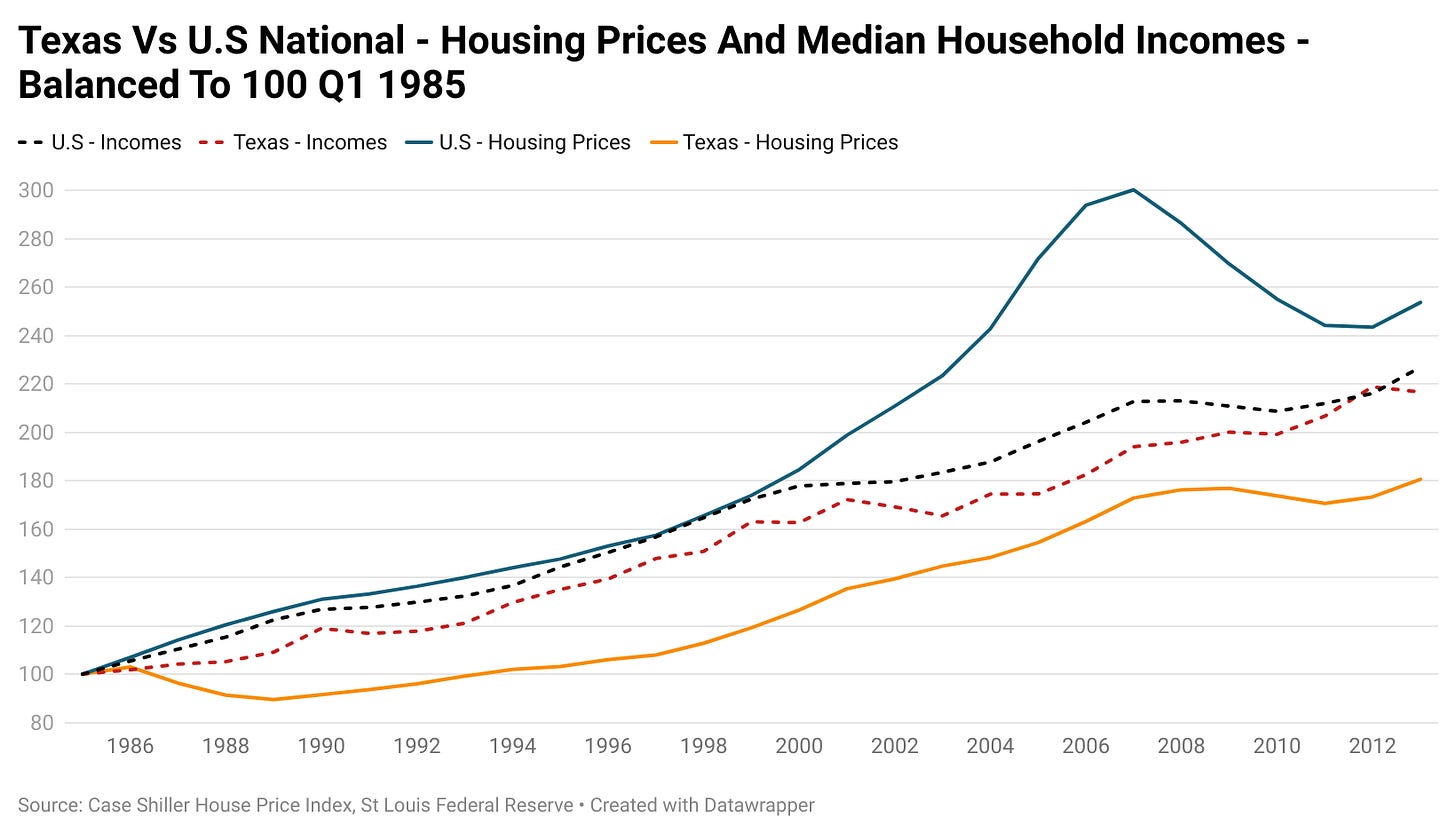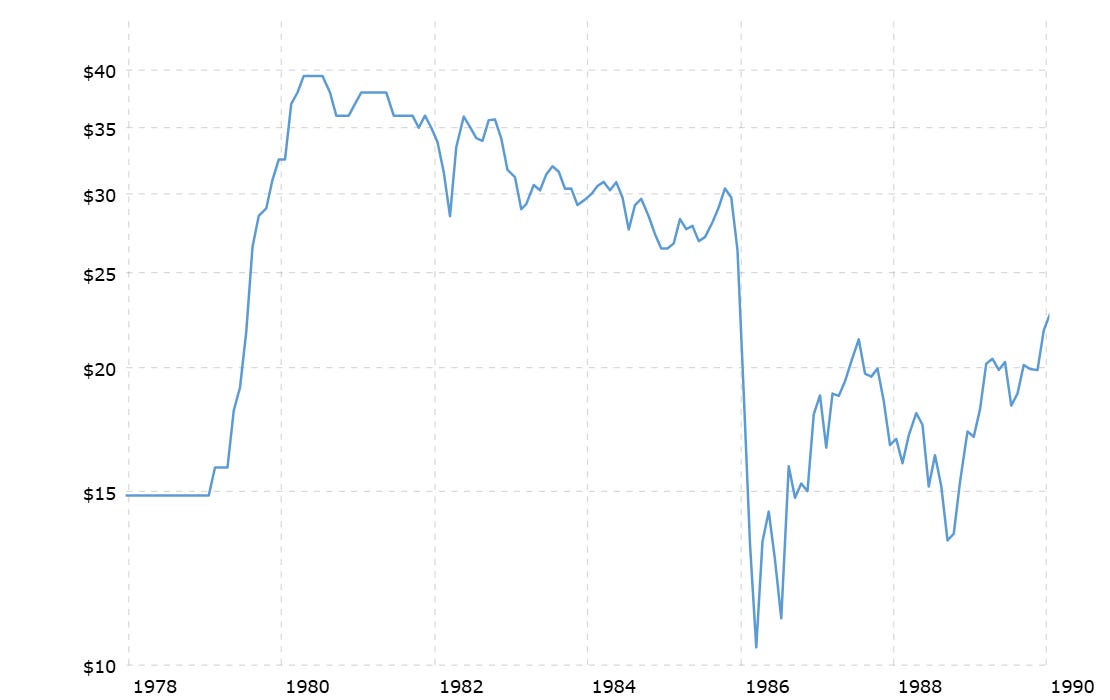During the GFC, the U.S. state of Texas emerged relatively unscathed.
To get a handle on the relative performance of the Texas housing market during this era, we’ll also be looking at the Texas economy, labor market, and foreclosure rates, as well as some commentary from academia.
A Bit Of Background – The Lone Star State
To find the point of major divergence between Texan and national U.S. housing prices, we need to go back to the days of Marty McFly and Doc Brown, 1985.
Between October 1985 and March 1986, the cost of a barrel of oil (WTI) fell by over 65%, following, amongst other catalysts, Saudi Arabia increasing its daily oil production from 2 million barrels per day to 5 million barrels per day.
1980’s Oil Prices (WTI)
While housing prices in the rest of the U.S. rose, in Texas they fell, as a period of over half a decade of a booming oil industry came to an end. It would take 8 years for Texan housing prices to recover to their previous highs, while in the broader U.S. housing prices had risen by over 40%.
When the Great Recession hit in December 2007, Texas housing prices had risen by 74.7% since our 1985 point of divergence, with the broader U.S. up by 195.9%.
While the median national household income had risen by 113.0% versus 95.8% in Texas, on balance, this additional income was significantly outweighed by the significantly greater debt burden resulting from higher housing prices when the Great Recession came knocking.

Not long after the onset of the Global Financial Crisis, Texas once again took a sizable hit from its links to the oil industry, as the price of oil dropped by over 77% in a little over 6 months.

Yet despite Texas being a major epicenter for another energy sector downturn, it performed better than the national average when it came to both its labour market and home foreclosure rates.
A Unique Case
According to data from the Case Shiller U.S. Housing Price Index, between the peak in housing prices at a national level in Q2 2006 and the trough in prices in Q4 2011, housing prices fell by 26.7%.
Meanwhile, across the same period in Texas, the average home sale price rose by 5.6%. Based on the absolute peak in Texas housing prices in Q4 2008 and Q4 2011, housing prices fell by a total of 3.4%.

Housing prices and the associated mortgage burdens being significantly smaller in Texas played a role in the housing market and the broader state economy weathering the storm of the Great Recession better than most.
In the words of a paper authored by the Texas A&M Real Estate Center:
“The absence of artificially inflated home prices in conjunction with a resilient job market buffered the negative effects on the state’s economy and housing market.”
While Texas was generally just as exposed to risky elements of the era, such as ‘teaser rates’ and ‘NINJA loans,’ the simple reality was that smaller housing debt burdens played a significant role in the much lower foreclosure rates than the national average.
According to an analysis from Texas A&M, foreclosure rates in Texas rose by approximately 1 percentage point to a peak of a little over 2% of all mortgages. The national average foreclosure rate rose by a bit over 3.5 percentage points, from 1% of all mortgages to 4.5%.
To what degree this relative strength of Texan households extended into the broader economy is naturally very much debatable. But there is an argument to be made that the less indebted and less financially troubled than average Texan households played a significant role in cushioning the blow to the state’s labour market and broader economy.
In terms of headline GDP, from peak to trough, the broader U.S. economy contracted by 3.55% during the Great Recession, while the Texas economy contracted by 2.0%. Considering that at the start of 2008, the oil, gas and broader resources sector accounted for over 14% of Texan GDP, this makes the performance all the more impressive.

When the U.S. entered the Great Recession, unemployment in Texas was 4.4%, with a national figure reading 5.0%. Texan unemployment would rise to a peak of 8.3% (3.9 ppt rise), and unemployment at a national level would rise to 10.0% (5.0 ppt rise).

While an argument can certainly be made that the smaller rise in unemployment played a major role in limiting the contraction of the Texas economy and reducing the rate of foreclosures, the magnitude by which Texas outperformed the national average suggests there were other forces at work.
The sharp deterioration in the resources sector also theoretically should have, in a vacuum, placed greater than average upward pressure on unemployment and downward pressure on economic growth, yet still, Texas experienced a relative outperformance.
The Takeaway
While there are arguments to be made that there are a multitude of factors at work, there is a strong case that lower housing prices and lower levels of household debt helped to insulate the Texan housing market from the crash-like conditions experienced in much of the rest of the country.
With fewer households in severe financial difficulty than the average, this cushioned the blow of the Great Recession on the Texas economy to at least some degree.
Which raises a series of interesting questions. Most notably, if a state or nation has a reasonably robust underlying pre-crisis economy and housing prices broadly in line with average metrics going back over half a century, even a severe commodity shock can be shrugged off with relative ease.
The lessons for Australia are obvious.


